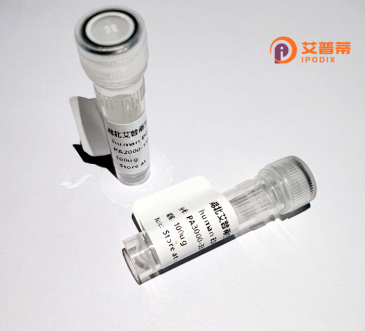
| 纯度 | >90%SDS-PAGE. |
| 种属 | Human |
| 靶点 | CLIPR-59 |
| Uniprot No | Q96DZ5 |
| 内毒素 | < 0.01EU/μg |
| 表达宿主 | E.coli |
| 表达区间 | 1-547aa |
| 氨基酸序列 | MTKTDPAPMA PPPRGEEEEE EEEDEPVPEA PSPTQERRQK PVVHPSAPAP LPKDYAFTFF DPNDPACQEI LFDPQTTIPE LFAIVRQWVP QVQHKIDVIG NEILRRGCHV NDRDGLTDMT LLHYACKAGA HGVGDPAAAV RLSQQLLALG ADVTLRSRWT NMNALHYAAY FDVPDLVRVL LKGARPRVVN STCSDFNHGS ALHIAASSLC LGAAKCLLEH GANPALRNRK GQVPAEVVPD PMDMSLDKAE AALVAKELRT LLEEAVPLSC ALPKVTLPNY DNVPGNLMLS ALGLRLGDRV LLDGQKTGTL RFCGTTEFAS GQWVGVELDE PEGKNDGSVG GVRYFICPPK QGLFASVSKI SKAVDAPPSS VTSTPRTPRM DFSRVTGKGR REHKGKKKTP SSPSLGSLQQ RDGAKAEVGD QVLVAGQKQG IVRFYGKTDF APGYWYGIEL DQPTGKHDGS VFGVRYFTCP PRHGVFAPAS RIQRIGGSTD SPGDSVGAKK VHQVTMTQPK RTFTTVRTPK DIASENSISR LLFCCWFPWM LRAEMQS |
| 分子量 | 59.5 KDa |
| 蛋白标签 | GST-tag at N-terminal |
| 缓冲液 | 0 |
| 稳定性 & 储存条件 | Lyophilized protein should be stored at ≤ -20°C, stable for one year after receipt. Reconstituted protein solution can be stored at 2-8°C for 2-7 days. Aliquots of reconstituted samples are stable at ≤ -20°C for 3 months. |
| 复溶 | Always centrifuge tubes before opening.Do not mix by vortex or pipetting. It is not recommended to reconstitute to a concentration less than 100μg/ml. Dissolve the lyophilized protein in distilled water. Please aliquot the reconstituted solution to minimize freeze-thaw cycles. |
以下是关于重组人CLIPR-59蛋白的3篇代表性文献摘要,简明概括供参考:
1. **"CLIPR-59 regulates lipid storage and adipocyte differentiation through interaction with the small GTPase Rab11"**
- **作者**: Lambert, J. et al.
- **摘要**: 本研究揭示CLIPR-59通过与Rab11相互作用调控脂滴形成和脂肪细胞分化。重组人CLIPR-59蛋白的体外实验显示其能够结合Rab11并影响脂质代谢相关通路,表明其在代谢疾病中的潜在作用。
2. **"CLIPR-59 facilitates anterograde AMPA receptor transport during synaptic plasticity"**
- **作者**: Pérez-Morga, D. et al.
- **摘要**: 文章发现CLIPR-59通过与细胞骨架蛋白(如微管结合蛋白EB1)的相互作用,促进突触中AMPA受体的前向运输。重组蛋白的过表达实验显示其增强神经元突触传递,提示对神经可塑性的调控功能。
3. **"Structural and functional analysis of the CLIPR-59 C-terminal domain in Golgi membrane trafficking"**
- **作者**: Li, X. & Du, L.
- **摘要**: 通过重组CLIPR-59的C端结构域表达和晶体结构分析,发现其能够结合PI4P脂质并调控高尔基体膜运输过程,揭示了其在细胞器动态平衡中的分子机制。
以上文献从代谢调控、神经运输及结构功能等角度探讨了CLIPR-59的生物学作用,可根据研究重点进一步查阅原文。
CLIPR-59. also known as CLIP3 or CAP-GLY domain-containing linker protein 3. is a cytosolic protein implicated in intracellular trafficking and signaling. It contains two distinct structural domains: an N-terminal CAP-GLY domain, which mediates interactions with microtubules, and a C-terminal domain that binds to protein phosphatase 1 (PP1) or other partners, regulating enzymatic activity. CLIPR-59 is thought to act as a scaffold, linking vesicular transport machinery to signaling pathways, particularly in lipid metabolism and glucose homeostasis. Studies suggest its role in promoting the translocation of glucose transporter GLUT4 to the plasma membrane upon insulin stimulation, highlighting its potential relevance in metabolic disorders like diabetes.
Recombinant human CLIPR-59 protein is produced using expression systems such as *E. coli* or mammalian cells, enabling high-purity yields for functional studies. Its production facilitates research into molecular mechanisms underlying vesicle trafficking, signal transduction, and metabolic regulation. Additionally, it serves as a tool to explore interactions with microtubule-associated proteins, kinases, or phosphatases, offering insights into pathologies like neurodegeneration or cancer. As a therapeutic target, understanding CLIPR-59’s role in metabolic dysregulation or cellular transport defects remains a key focus, driving interest in its recombinant form for drug discovery and mechanistic biology.
×